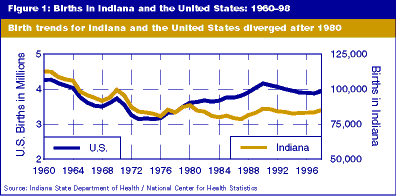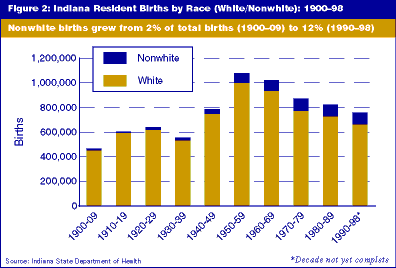Hoosier Births Stage a Comeback
Births in Indiana are on the rise according to data recently released by the Indiana State Department of Health for 1998, the latest year for which data are available. Indiana births in 1998 reached 85,055, the highest total since 1991. The 1998 total was 2% higher than 1997 and represents the largest annual increase in either absolute or percentage terms reported to this point in the 1990s.
Figure 1 shows birth trends for Indiana and the United States from 1960, the tail end of the baby boom, through 1998. While the scale of each axis is necessarily different, the trend is evident. The boom is generally acknowledged to have ended in 1964, after which U.S. births fell below 4 million and Indiana births dropped below 100,000.

For both the state and the nation, births reached a 40-year low in the mid-1970s, a period some social scientists have dubbed the "birth dearth." The stork's deliveries picked up from that point, but the action has been much hotter at the national level than in Indiana. The dearth was followed, beginning around 1980, by the "echo boom," a notable increase in births attributed to the vast cohort of boomers having their own children. The impact of the echo boom in Indiana has been minimal, however. Hoosier births have not yet returned to the 1980 level. In the United States, births have run higher than the national 1980 tally for 18 years running. U.S. births even returned to baby-boom heights, exceeding 4 million from 1989 to 1993. The peak year for Indiana's echo boom was 1990, with almost 86,000 births, well below the baby-boom levels. Indiana's flatter birth trend over the past 20 years is probably due to the net outflow of young adults from the state in the early part of the 1980s.
Figure 2 depicts the changing racial composition of births in the state throughout the 20th century. Because detailed race categories were not recorded on birth certificates for much of the century, long-range historical analysis is limited to two categories: white and nonwhite (recorded as race of the mother). While nonwhite births remain a fairly small proportion of all Indiana births, the number and share are growing. As shown in Figure 2, white births peaked in the 1950s and have declined since then. Nonwhite births, in contrast, have continued a gradual increase over the century, climbing to 12% of all Indiana births in the 1990-98 period from 2% in the 1900-09 decade.

